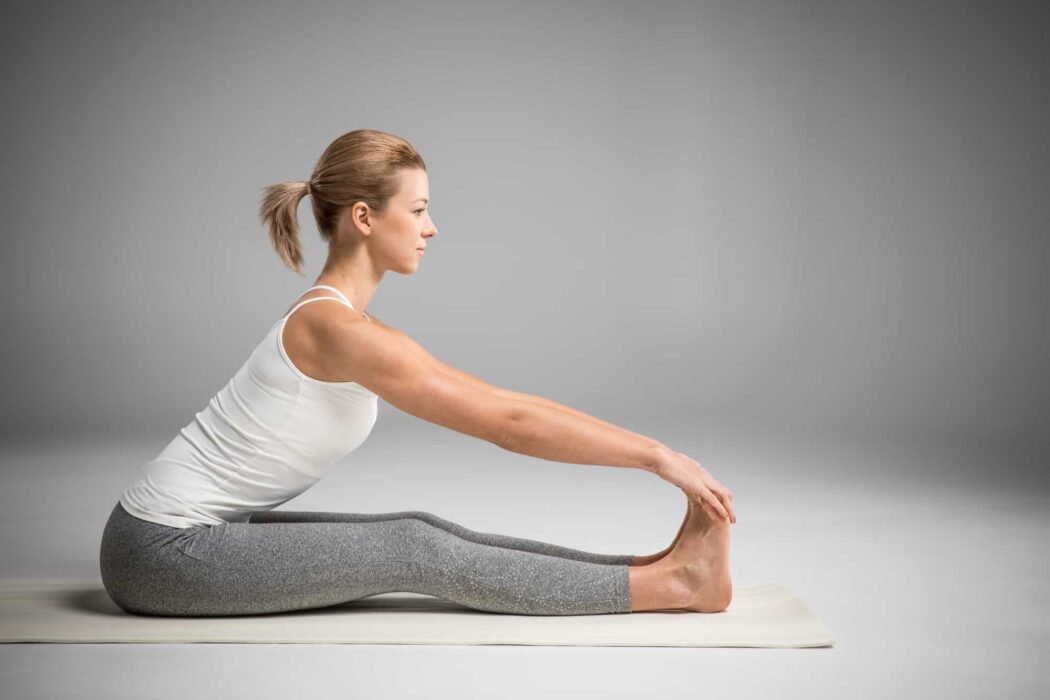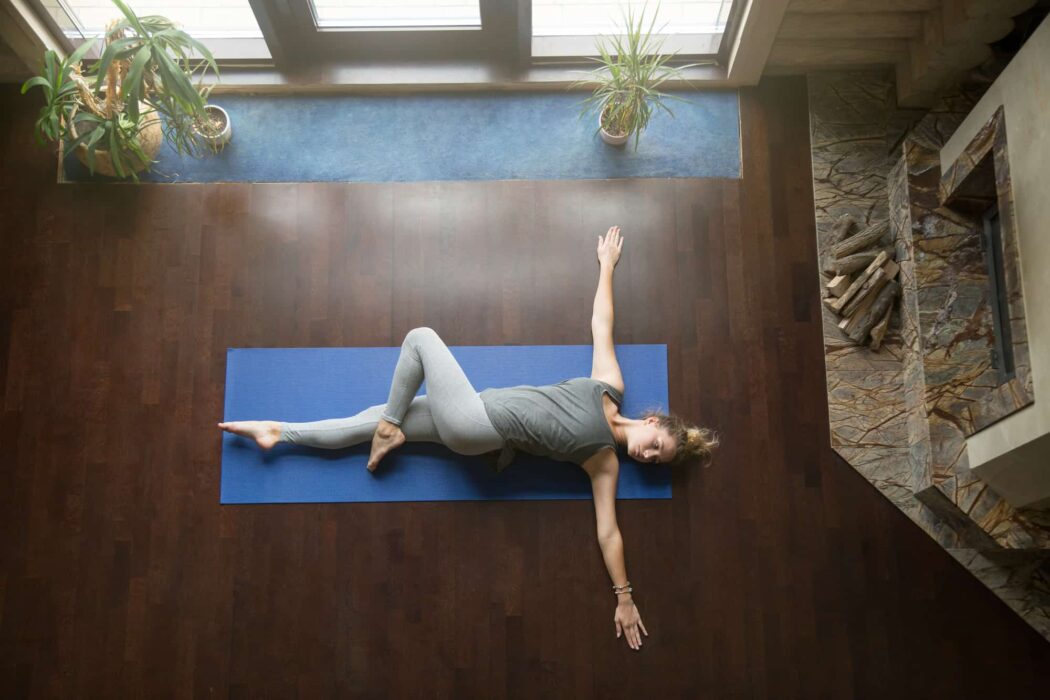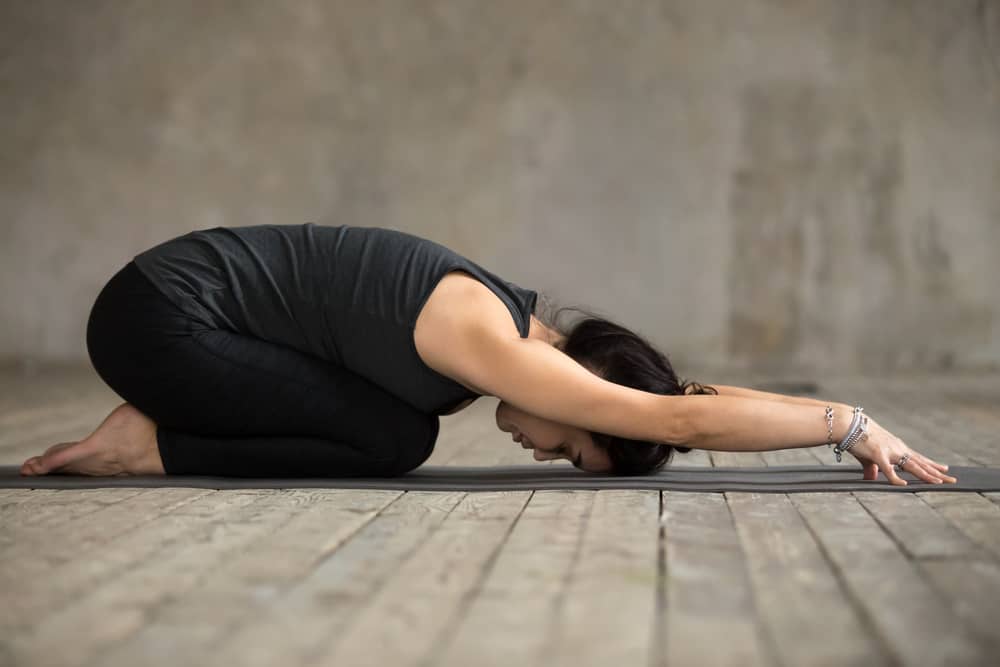Feeling a balloon or something heavy and swollen in your belly means you have bloating. Often this is a result of a substantial or speedy meal you had before. The best way to relieve this condition is to fart. Good thing if that happens naturally, but if you have some troubles doing this, use these simple yoga asanas to reduce the bloating:
- Seated Forward Bend (Paschimottanasana)
- Child’s pose (Balasana)
- Wind-Relieving Pose (Pawanmuktasana)
- Supta Matsyendrasana (Supine Twist)
Basic Yoga Poses to Reduce Bloating
Seated Forward Bend (Paschimottanasana)

- Sit down on the mat, press your sit bones to the floor, legs are pressed to it each other.
- Ground your heels into the floor and flex your feet
- As you inhale, lengthen your spine, sending the head crown into the ceiling. You can also put your hands up and stretch up, but mind pushing your shoulder blades away from your ears.
- On the exhale, lean forward and fold.
- Place your hands alongside your legs, either on your fingertips or palms.
Ensure your back is not rounding. You may use a pillow under your belly to increase the compression effect and keep the back flat.
Wind-Relieving Pose (Pawanmuktasana)

As you can see from the name, this asana works specifically to relieve gas.
- Lie down on the mat, press the back to the floor
- As you exhale, grab your knees and pull them closer to the chest
- Roll your neck towards the knees trying to reach your knees with a forehead
- On an inhale, bring your heads on the mat and release your core muscles.
Repeat 5-10 breath cycles.
Note that gas may start to go out during this pose, so you may want to practice it in private. Also, to make it easier, you can do it with one leg at a time.
Supta Matsyendrasana (Supine Twist)

This pose helps to relax and massage your gut.
- Lie on the back facing up
- Bend your left knee and lift it in line with your hip (or even chest If you want to go deeper)
- Twist the left knee over the right leg and try to put it on the ground. You can use your right hand to press on the knee gently.
- The right leg is straight and pressed to the mat.
Check to keep both your shoulder blades on the floor and relax into the pose. Hold for 1-3 minutes, breathe smoothly.
Child’s pose (Balasana)
Finalize your practice with this restorative pose. You can use a pillow under your belly to increase the compression on the abdomen in the Child’s pose.

How Yoga Poses Help with Bloating?
Yoga asanas work with the whole body, including your digestive system. So even you haven’t got bloating at the moment, adding twists and abdomen contracting poses into your practice will help prevent unpleasant fart situations. Such posture helps massage and compress your organs gently, improve blood circulation in your digestive tract.
In addition, breathing helps remove all the waste (be it physical or emotional) from your body, according to Desikachar and his book “The Heart of Yoga.” So, focusing on your exhale and inhale length will also add more effect to practice for bloating.
What Is the Main Cause of Bloating?
Around 16-30% of people experience bloating, so this is a widespread issue according to the National Institutes of Health research database. There is no one common reason for bloating. Stress, an unhealthy diet, and eating on the go can contribute to gas production in your stomach even if you are a completely healthy person.
Here are some known factors that increase the risk of bloating:
- Overeating
- Extra sensitive digestive system
- Specific food intolerance and allergies
- Swallowed air and gas (eating fast, drinking sweet beverages like soda and alcohol, chewing gum, etc.)
- Eating a meal that contains gas-increasing products (beans, lentils, etc.)
How Can Stress Cause Weight Loss? Reasons and Prevention
When Is Bloating Serious?
In most cases, a bloated belly is a temporary thing that can be taken away with a diet correction and simple physical activity. However, in some instances, this is a signal of a more severe issue with your digestion system. So be sure to consult your health provider and go through a health check if the bloating persists and is accompanied by the below conditions:
- Vomiting
- Intense pain
- Injury
- Bloody stools
- Recent surgery
- Liver or kidney diseases